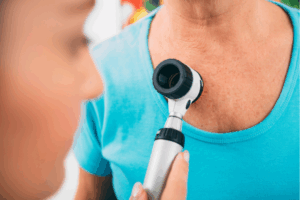Oncology
Locally Advanced Basal Cell Carcinoma
Epidemiology of Basal Cell Carcinoma
BCC continues to increase in prevalence. In the United States, for example, its prevalence is increasing at a rate of 4% to 8% annually. This is, in part, because our aging baby boomer population did not wear sunscreen. Interestingly, there is also an uptick in younger patients with BCC, particularly younger women who have tanning bed exposure.
<br>
Our hope was that skin cancer rates would decline in younger generations with sunscreen use and public health measures. We have yet to see that in the United States and in Western Europe, although BCC has leveled off in Australia, which, historically, has had the highest incidence rate. Australia currently has an aggressive public health campaign for self-skin examinations, and its primary care physicians receive training on what to look for. In addition, Australia’s health benefits cover medically necessary skin examinations.
<br>
UVR exposure is, by far, the number one environmental risk factor for BCC. This can be chronic exposure or intermittent intense exposure. In addition, patients with Fitzpatrick skin types I and II are more likely to sunburn and to be at high risk for BCC. Genetic predisposition can also play a role in a person having an increased risk, as can just age. As we get older, our immune systems are less functional in surveilling for malignant cells. So, people are more likely to develop skin cancers as they age, particularly if they have had a lot of UVR exposure.
<br>
I think that a lot of what is going to level off the BCC incidence rates in the United States and in Western Europe are demographic changes over time. The UVR damage has already been done in older generations. In addition, tanning bed use has gone down over time because people are realizing that it is a significant risk factor for skin cancer, particularly melanoma. There is more public awareness, as well as campaigns, about avoiding indoor tanning, and some states have enacted policies to restrict access to tanning beds for minors.
Bowers JM, Geller AC, Schofield E, Li Y, Hay JL. Indoor tanning trends among US adults, 2007-2018. Am J Public Health. 2020;110(6):823-828. doi:10.2105/AJPH.2020.305605
<br>
Cameron MC, Lee E, Hibler BP, et al. Basal cell carcinoma: epidemiology; pathophysiology; clinical and histological subtypes; and disease associations. J Am Acad Dermatol. 2019;80(2):303-317. Published correction appears in J Am Acad Dermatol. 2021;85(2):535.
<br>
Heaton H, Lawrence N. Nonmelanoma skin cancer in women. Int J Womens Dermatol. 2018;5(1):2-7. doi:10.1016/j.ijwd.2018.08.007
<br>
Melanoma Patients Australia. Self-skin checks – no regrets. Accessed August 2, 2025. https://melanomapatients.org.au/get-involved/self-skin-checks-no-regrets/
<br>
Naik PP, Desai MB. Basal cell carcinoma: a narrative review on contemporary diagnosis and management. Oncol Ther. 2022;10(2):317-335. doi:10.1007/s40487-022-00201-8











